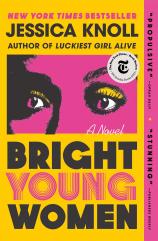Bright Young Women
Review
Bright Young Women
There’s a famous line about the difference between men and women attributed to Margaret Atwood: “Men are afraid women will laugh at them. Women are afraid that men will kill them.” In BRIGHT YOUNG WOMEN, which is inspired by the survivors of serial killer Ted Bundy, Jessica Knoll rightly puts the spotlight back on these incredibly brave women and away from the monster who tried to extinguish their light.
The novel features Pamela Schumacher, one of the survivors of Bundy’s infamous sorority house attack, which left two dead and two horribly injured. Told in three intersecting timelines, it details not only the harrowing experience of that night, but also the hell that Pamela and the surviving women had to endure afterwards. In addition, Knoll makes this compelling narrative a meditation on the misogyny of violence and why the killer was given most of the attention instead of the victims.
"BRIGHT YOUNG WOMEN reads like a thriller, but it is so much more than that. It’s about the misogyny of violence, sensationalism, sisterhood, the lessons we learn, and listening to our instincts. Above all, though, it’s about survival and how we deal with the hand we are dealt."
In the early morning hours of January 15, 1978, Pamela, the president of her sorority at Florida State University, awakens to a thud in her sorority house. Going downstairs to investigate, she hears frantic footsteps above her. She observes a man dressed in black and wearing a knit cap race past her in the foyer. Carrying something that looks like a baseball bat, he runs out the front door into the night. It isn’t until a few minutes later when Pamela makes a horrific discovery: her friends, Denise and Robbie, have been brutally beaten and assaulted. Two others in the house have been attacked, but they are the lucky ones. They survive.
As the authorities descend on the house and dawn draws near, Pamela has to formulate some sort of explanation to her sorority sisters. So begins her decades-long nightmare, where reverberations are felt long after the killer is put to death in Florida’s electric chair.
While visiting the families of the injured young ladies at the hospital the next day, Pamela meets Tina Cannon, who flew across the country because she’s convinced that the monster who did this is also responsible for the disappearance and probable murder of her girlfriend, Ruth, who went missing from Lake Sammamish State Park in Washington State in 1974. He most likely has done this many times before and will continue to do so until he’s caught.
At the same time, Pamela is experiencing a less-than-sensitive response from the university. A week or so after the attack, all the administration does is order new locks for the sorority house door. Despite some initial trepidation, Pamela joins forces with Tina. Along with local journalist Carl Wallace, they take off for Colorado to speak with the suspected killer’s former cellmate, hoping to garner information that could lead to his capture.
Back in Florida, the suspect is apprehended (he is never named in the book and is only referred to as “The Defendant”). Since she is the only eyewitness, Pamela will be testifying at the trial. She is disgusted and bewildered by the press dubbing him “good-looking” and “Kennedy-esque.” This odd treatment even extends to the trial judge. News reports highlight how the defendant attended law school and never graduated, but still decided to represent himself (along with several court-appointed attorneys), giving him the right to depose Pamela, further traumatizing her. She also has to wrestle with a tremendous amount of guilt and shame, believing that she had failed her friends that night.
Knoll skillfully shows how society and the media frame such horrible events, giving credence to the TV news adage “If it bleeds, it leads.” She is all about taking the power back from Bundy and restoring the attention to the survivors and victims in an effort to diminish the idolatry and mystique of the serial killer. Tina says, “I’ve tried to make sense of how someone who didn’t stalk his victims in advance ended up going after the best and the brightest. And I think that’s it, the thing they all had in common --- a light that outshone his. He targets college campuses and sorority houses because he’s looking for the cream of the crop. He wants to extinguish us --- we are the ones who remind him that he’s not that smart, not that good-looking, that there’s nothing particularly special about him.” They were “Bright Young Women.”
Inspired by a 2019 Rolling Stone article focusing on Kathy Kleiner Rubin, who survived the sorority house murders, Knoll deftly crafts a narrative that shows the crime from the only side that should matter --- that of the survivors and victims. BRIGHT YOUNG WOMEN reads like a thriller, but it is so much more than that. It’s about the misogyny of violence, sensationalism, sisterhood, the lessons we learn, and listening to our instincts. Above all, though, it’s about survival and how we deal with the hand we are dealt.
Reviewed by Bronwyn Miller on September 22, 2023
Bright Young Women
- Publication Date: August 6, 2024
- Genres: Fiction, Psychological Suspense, Psychological Thriller, Suspense, Thriller
- Paperback: 400 pages
- Publisher: S&S/Marysue Rucci Books
- ISBN-10: 1501153234
- ISBN-13: 9781501153235




